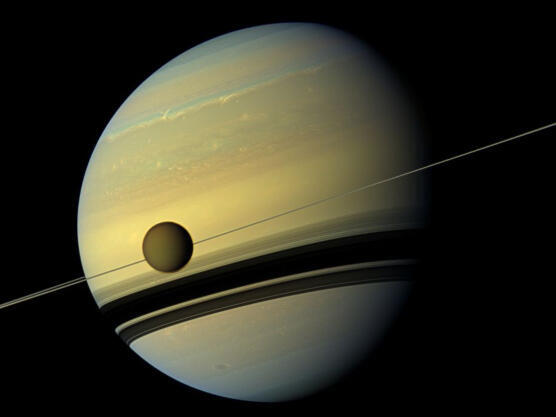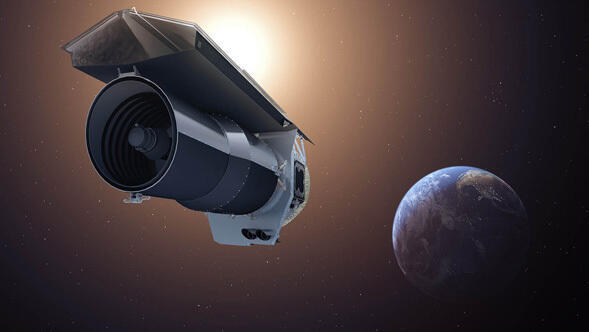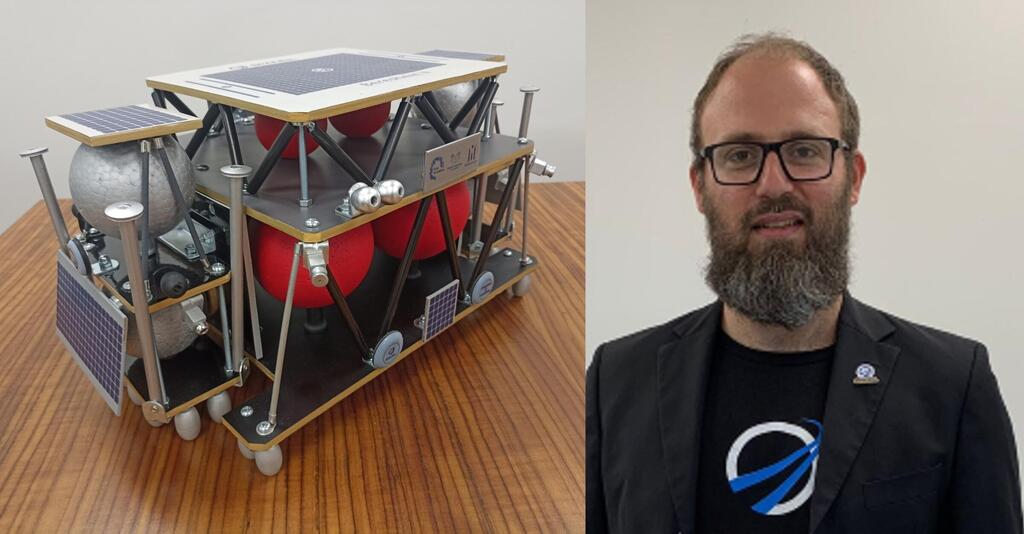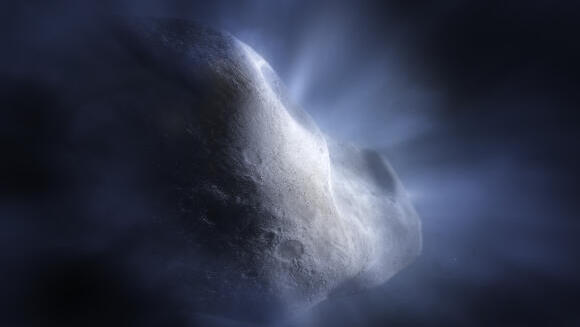Getting your Trinity Audio player ready...
When it comes to writing scientific trivia questions, it is advisable to avoid the question "Which planet in the solar system has the most moons?" Not because it's uninteresting, but because the correct answer is constantly changing.
Other stories:
In 2018, Jupiter took the lead with discoveries that increased the number of its known moons to 79, but a year later, in 2019, Saturn claimed the throne after new findings revealed that it has at least 82 moons. However, in February 2023, Jupiter reclaimed its title of the planet with the most moons, following the identification of additional moons orbiting it, which increased its total number of moons to 92, and that total is now at 95. Now, Saturn has once again surpassed Jupiter, unveiling a staggering 62 new moons, bringing its known total to 145 moons and reclaiming the title of King of Moons.
4 View gallery


Titan and another 144 moons...for now. Saturn's large moon against the backdrop of the planet and its rings in photo by Cassini spacecraft
(Photo: NASA/JPL-Caltech/Space Science Institute)
The moons that were discovered are all relatively small celestial bodies, with diameters not exceeding three kilometers, and they are not spherical. They are also found at considerable distances from the planet itself, situated within a range of 10 million to 30 million kilometers, much further than large and well-known moons. The discovery was made by two research teams using large, ground-based telescopes in Hawaii, one led by Scott Sheppard from the Carnegie Institute in Washington, and another led by Edward Ashton from the Chinese Academy in Taiwan. One reason for the discovery of so many moons is that “the simple definition of a moon is that it’s an object that orbits a planet,” Sheppard told The New York Times. As per this definition, the size of the object is inconsequential.
The researchers hypothesize that many of these moons are in fact remnants of larger moons that once orbited Saturn, and shattered into pieces due to collisions with asteroids, meteors and other moons. It is possible that those original moons were created “very early on in the solar system, possibly in the first hundred of million years after its formation," said Ashton, and Sheppard added that “they might be the last remnants of what formed in the giant planet region, likely very icy-rich objects.” Comprehensive research of these celestial bodies could potentially shed new light on the formation of planets and their ancient environment.
Even though Jupiter and its researchers have yet to have the final say regarding the number of its moons, the new findings place Saturn at a significantly higher position on the list, and the researchers estimate that the gap between them will widen even further. It appears that Saturn has a considerably greater number of small and distant moons, "potentially reaching into the thousands," Ashton estimated. Now the researchers will try to understand the reasons for this difference.
Water under your (asteroid) belt
New findings from the James Webb Space Telescope point to the presence of water in a comet situated in the asteroid belt, between the orbits of Mars and Jupiter. The finding reinforces the theory that such comets may have been the source of water on Earth. Using the telescope's spectrometers, researchers examined the composition of the gas cloud around comet 238P/Read, and, in an article published in journal Nature, they report that this cloud indeed contains water vapor, likely a remnant of water from the early solar system.
The prevailing theory suggests that comets were formed in the cold regions at the edge of the solar system, and until recently it was thought that they could not last long on a trajectory close to the sun, due to their ice evaporating or, more accurately, sublimating.
"In the past, we've seen objects in the main belt with all the characteristics of comets, but only with this precise spectral data from [the] Webb [telescope] can we say: yes, it's definitely water ice that is creating that effect," explained the head of the research team, Michael Kelley, from the University of Maryland. "With Webb's observations of Comet Read, we can now demonstrate that water ice from the early solar system can be preserved in the asteroid belt."
Repair services in space
The Italian Space Agency has awarded $256 million to a group of companies aiming to develop robotic missions for repairing and refueling satellites in low Earth orbit, thereby extending their operational lifespan. The first in-orbit servicing demo mission is planned for 2026, but details have not yet been released. The Franco-Italian company Thales Alenia Space has announced that the service spacecraft will be equipped with a robotic arm for capturing the target satellite, and will test capabilities such as in-space refueling, repairing or replacing damaged components, modifying the satellite's trajectory, or maneuvering it into an orbit that will lead to its incineration in the atmosphere.
The development group also includes several national research institutes in Italy, as well as space companies Telespazio, Avio and D-Orbit. “By working together they will generate synergies that ensure the future viability of the space sector while also developing all-Italian technologies to support the growth of the country’s space industry,” said Massimo Comparini, deputy CEO, senior executive vice president of observation, exploration and navigation of Thales Alenia Space.
A no less ambitious space repair mission is the plan of the U.S. Space Force to resurrect the Spitzer Space Telescope, which ceased operation around three years ago, after 16 fruitful years of infrared radiation observations. The launch company Rhea received a grant of about $250,000 for an initial feasibility study of the idea, in collaboration with established and experienced entities in the space sector, such as Lockheed Martin and Johns Hopkins University.
Given the Spitzer telescope operated using infrared radiation, it had to function at extremely low temperatures. In its early years, it was cooled by liquid helium, and when the helium was depleted, it continued to operate less efficiently using passive cooling, based on its heat shields. The telescope is in a sun-synchronous orbit; that is, it orbits the sun in the same path as the Earth, but at a distance of about 300 million kilometers from us, making the mission to resuscitate it a particularly big challenge.
"This would be the most complex robotic mission ever performed by humanity," said Rhea CEO, astrophysicist Shawn Usman, in a company statement.
4 View gallery


Can the veteran telescope be revived? The Spitzer telescope in its orbit around the sun
(Photo: NASA/JPL)
According to the initial plan, the mission to revive the telescope is set to launch in 2026. The servicing spacecraft will naturally refill or replace the helium tanks, and possibly other systems as well. After successfully restarting the telescope, the servicing spacecraft will remain nearby, functioning as a relay station to enhance communication with the telescope. It's worth noting that this is only a preliminary feasibility study, with an extremely ambitious timeline.
And more on the topic of venerable telescopes, two launch companies, Momentus and Astroscale, which also maintains a development center in Israel, have submitted a proposal to NASA for a mission that will extend the life of the Hubble Space Telescope by relocating it to a higher orbit. The two companies, which are in the process of developing technologies for space debris removal and satellite lifespan extension, have proposed to launch a spacecraft to approach Hubble, elevate it to an orbit higher by about 50 kilometers, to compensate for the altitude it has lost, and then clear its path of space debris.
Unlike Spitzer, the Hubble telescope remains operational after more than 30 years in space, partly due to five manned missions conducted by the space shuttle, whose crews carried out repairs and entire system replacements, with the last mission taking place in 2009. At present, NASA lacks a tangible plan to prolong the operation of the veteran telescope, although it did issue a call for ideas on the subject at the end of last year – a call that has since closed. Currently, there's no budget allocated for such a project, and the ideas under review exist only in theory.
Beresheet 2 Lunar Mission Faces Budget Difficulties
The complex Beresheet 2 lunar mission, which includes a satellite and two landers, encountered unforeseen difficulties this week when the main group of donors to the SpaceIL association declared a halt in funding for the project. The group of donors, predominantly Morris Kahn, who funded a significant part of Beresheet 1, Patrick and Lina Drahi, and the Moshal family, have already contributed about 45 million dollars to the project, but have now withdrawn their commitment to donate another 45 million dollars, out of a total cost of approximately $100 million.
4 View gallery


A race to raise $10 million within six weeks. Kfir Damari with a model of the Beresheet 2 spacecraft
( Photo: SpaceIL, Ettay Nevo)
“It is with a very heavy heart that we have to come to the decision to stop our funding. These times obligate us to invest our resources and time in other philanthropic projects,” Morris Kahn stated on behalf of the group.
"We were taken by surprise by the announcement. We were not prepared for this," Kfir Damari, deputy CEO of SpaceIL, told the Davidson Institute. "We have already placed procurement orders based on this budget, with components and systems currently in production and expected to be delivered to us soon. If we do not succeed in raising at least $10 million within the next six weeks, we will be unable to meet our obligations and contracts and may even have to cancel the project."
Following the announcement, at the beginning of the week, the association's staff launched a search for private donors to help bridge the newly emerged budget gap. "We are exploring all kinds of possibilities for raising the necessary funding, including collaborations with space companies, and even with countries, along with soliciting donations from the public via a crowdfunding campaign. Given the tight schedule, we believe that the most practical solution, at least for the initial amount, is finding private donors so that we can proceed with the project and land an Israeli spacecraft on the moon," stated the association.


